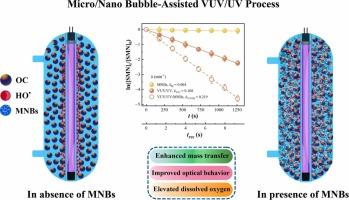利用空气微/纳米气泡强化真空紫外线/紫外线工艺,实现先进的水处理技术
IF 11.3
1区 环境科学与生态学
Q1 ENGINEERING, ENVIRONMENTAL
引用次数: 0
摘要
真空紫外(VUV)/紫外(UV)工艺的关键限制是VUV穿透时间短,导致局部羟基自由基(HO●)浓度相对较高,以及相关的传质限制。研究了VUV/UV工艺与空气微纳气泡(MNBs) (VUV/UV/MNBs)相结合对有机污染物降解的增强作用。以磺胺甲基嗪(SMN)为模型污染物,VUV/UV/MNBs工艺的降解速率(0.219 min−1)是VUV/UV工艺(0.108 min−1)的两倍。这种增强归因于三个因素:(1)空气MNBs改善了溶液内的混合和传质,抑制了HO●自重组,表现为H2O2浓度的降低;(2)空气MNBs优化了溶液中的光行为,使VUV穿透时间更长;(3)溶解氧水平的升高促进了额外的HO●生成,抑制了碳中心自由基的重组。定量评价了这些因素的贡献。此外,在溶解有机物和阴离子(即Cl -、NO3 -、SO42 -)共存的情况下,空气MNBs的增强作用持续存在,并探讨了光反应器内径和初始SMN浓度的影响,以寻求潜在的实际应用。本研究证明了新型的VUV/UV/MNBs是一种高效、无化学物质的高级水处理工艺。本文章由计算机程序翻译,如有差异,请以英文原文为准。

Enhanced vacuum ultraviolet/ultraviolet process for advanced water treatment by using air micro/nano bubbles
The key constraint of vacuum ultraviolet (VUV)/ultraviolet (UV) process is the short VUV penetration resulting in a relatively high local concentration of hydroxyl radicals (HO●) and associated mass transfer limitation. This study investigated the enhancement of organic contaminant degradation by combining VUV/UV process with air micro/nano bubbles (MNBs) (VUV/UV/MNBs). Using sulfamethazine (SMN) as a model contaminant, the degradation rate in the VUV/UV/MNBs process (0.219 min−1) was twice that of the VUV/UV process (0.108 min−1). This enhancement was attributed to three factors: (1) air MNBs improved mixing and mass transfer within solution, suppressing HO● self-recombination, as evidenced by a decrease in H2O2 concentration; (2) air MNBs optimized the light behavior in solution, enabling longer VUV penetration; (3) elevated dissolved oxygen levels facilitated additional HO● generation and inhibited the recombination of carbon-centered radicals. The contributions of these factors were quantitatively evaluated. Additionally, the enhancement by air MNBs persisted in the presence of dissolved organic matter and coexisting anions (i.e., Cl–, NO3–, SO42–), and the effects of photoreactor inner diameter and initial SMN concentration were explored for potential practical applications. This study demonstrates the novel VUV/UV/MNBs as a high-efficiency and chemical-free advanced water treatment process.
求助全文
通过发布文献求助,成功后即可免费获取论文全文。
去求助
来源期刊

Journal of Hazardous Materials
工程技术-工程:环境
CiteScore
25.40
自引率
5.90%
发文量
3059
审稿时长
58 days
期刊介绍:
The Journal of Hazardous Materials serves as a global platform for promoting cutting-edge research in the field of Environmental Science and Engineering. Our publication features a wide range of articles, including full-length research papers, review articles, and perspectives, with the aim of enhancing our understanding of the dangers and risks associated with various materials concerning public health and the environment. It is important to note that the term "environmental contaminants" refers specifically to substances that pose hazardous effects through contamination, while excluding those that do not have such impacts on the environment or human health. Moreover, we emphasize the distinction between wastes and hazardous materials in order to provide further clarity on the scope of the journal. We have a keen interest in exploring specific compounds and microbial agents that have adverse effects on the environment.
 求助内容:
求助内容: 应助结果提醒方式:
应助结果提醒方式:


